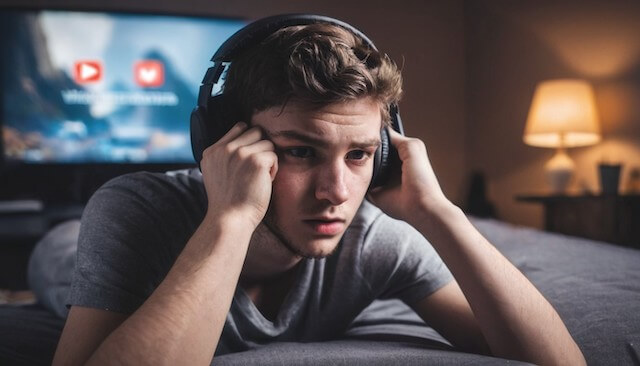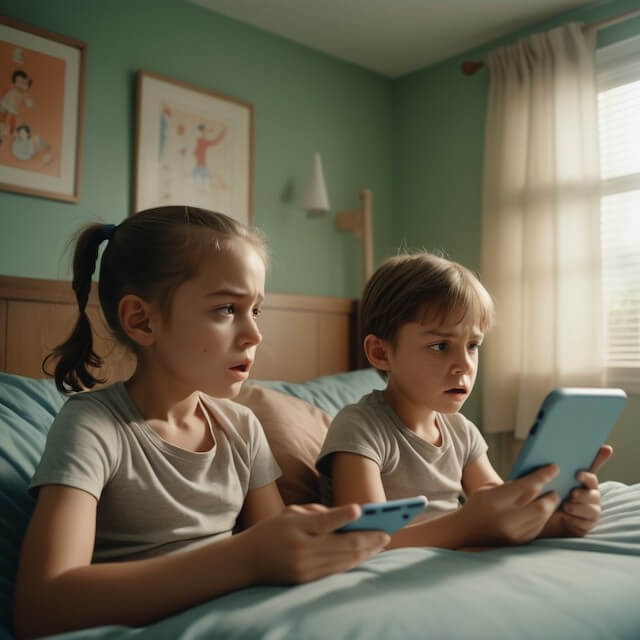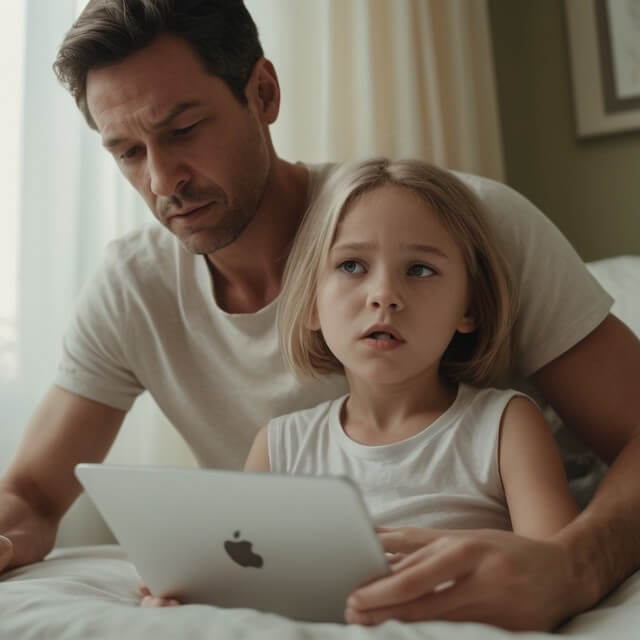In today’s digital age, children are growing up with screens as a constant presence in their lives. From smartphones to tablets, televisions to video games, screen time has become an integral part of their daily routine. However, what many parents may not realise is that excessive screen time can lead to screen addiction, a silent threat that can have detrimental effects on a child’s development and well-being.
Something went very wrong for adolescents in the early 2010s. The sudden affordability of smartphones, combined with the increased use of social media applications and inexpensive graphically dazzling video games, laid the fertile soil for an entire generation of children to look forward to nothing else except engaging with digital devices in solitude.

Ten years ago, a report found that 25% of teenagers said they were online almost constantly. By 2022, that number had nearly doubled. Anxiety and its associated disorders seem to be the defining mental illnesses of young people today. Developmental disorders, ADHA, autism spectrum disorders, and intellectual disabilities followed a similar path. Children reported experiencing trauma in the absence of a digital device.
A largely unregulated and unadulterated frenzy had begun before we could even imagine what was going to take place. Children are being raised by algorithms and applications whose creators would not dare let their own children use them. Former Google and Facebook Ethicists Tristian Harris famously said, “Technology is causing disconnected things, shortening of attention spans, polarisation, outrage-ification of culture, mass narcissism, electrical engineering, and its ultimate goal is designed to keep you addicted.”. He is also quoted as saying, “You’re either on, and you’re connected and distracted all the time, or you’re off, but then you’re wondering, Am I missing something important? In other words, you’re either distracted or you have a fear of missing out.”.
I was a design ethicist at Google, where I studied how do you ethically steer people's thoughts? Because what we don't talk about is how the handful of people working at a handful of technology companies through their choices will steer what a billion people are thinking today.
Tristian Harris

His experience speaks volumes about the potential long-term damage being caused by these revolutionary devices and their so-called connection to the world at large. However, constant engagement with technological devices is a “too big to fail” conundrum, and questioning its actual impact requires people to engage even more with these devices.
There is nothing like being connected, stuck in your bedroom for ten hours a day looking at a piece of glass constantly engaging our dopaminergic pathway. The brain’s reward system. Normally involved in reward is the so-called mesolimbic system, which is formed by projections of midbrain dopamine neurons of the ventral tegmental area (VTA) to the striatum, prefrontal cortex, amygdala, hippocampus, and many other structures of the limbic system.

The same reward system gambling addicts, pokie machine addicts, heroin addicts, and alcoholics are responding to. Screen addiction is no less pervasive and potentially much more dangerous than all these vices combined, because we don’t need the latter for any reason other than escape. Digital devices are a vital part of communication, study, social connection, professional employment, and the community at large, which makes their utility even more precarious and hostile.
Rates of depression and anxiety amongst teenagers and adolescents had been fairly stable in the 2000s but rose by more than 50 percent in many studies from 2010 to 2019. The suicide rate rose 48 percent for adolescents ages 10 to 19. For girls ages 10 to 14, it rose 131 percent in the United States alone.

The problem was not limited to the U.S., as familiar patterns emerged around the same time in Canada, the U.K., Australia, New Zealand, the Nordic countries, and beyond.
By a variety of measures and in a variety of countries, the members of “Screen Generation”: Generation Z (born in and after 1996) are suffering from anxiety, depression, self-harm, and related disorders at levels higher than any other generation for which we have data.
According to numerous studies, teens spend anywhere from seven to nine hours on screens on average.
Widely-cited survey results published by Common Sense Media in 2021 reported teens spend an average of eight hours and thirty-nine minutes a day on entertainment screen use, with more boys relying on screens for entertainment than girls (about an hour more on average, in both teens and tweens).

Where social media is a bigger draw for girls, video games tend to draw boys (by a ratio of about 4:1, according to the 2021 Common Sense Media survey).
The data indicates video games are to young males what social media is to girls.
Ungdata, a Norwegian national youth survey used by researchers in a study published in 2021, reported that 69 percent of boys said that it was “very important” to keep in touch with their friends through gaming, compared to only 16 percent of girls.
Screen addiction in children is a growing concern, with studies showing it can impact their physical and mental health, as well as their social and emotional development. From decreased physical activity and obesity to impaired focus and sleep disturbances, the consequences can be far-reaching.

Understanding Screen Addiction in Children
Screen addiction in children is a complex issue that requires a deeper understanding. It is not just about the amount of time spent in front of screens but also the psychological and emotional dependence on them. Children may use screens as a form of escape, to cope with stress or anxiety, or to seek validation through social media. Understanding the underlying reasons behind screen addiction can help parents address the issue more effectively.
Research suggests that screen addiction in children is linked to the release of dopamine, a neurotransmitter associated with pleasure and reward. When children engage in screen activities, such as playing video games or scrolling through social media, they experience a surge of dopamine, which reinforces the behaviour and leads to cravings for more screen time.

The Impact of Screen Addiction on Children's Development
The consequences of screen addiction on children’s development cannot be overstated. Excessive screen time has been linked to various physical and mental health issues. One of the most concerning effects is the impact on physical activity levels. Children who spend excessive time in front of screens are more likely to lead sedentary lifestyles, which can contribute to obesity and other health problems.
Moreover, screen addiction can also affect cognitive development. Excessive screen time has been associated with decreased attention span, impaired memory, and reduced problem-solving skills. The constant stimulation and multitasking required by screens can hinder children’s ability to focus and concentrate on tasks that require sustained attention.
Additionally, screen addiction can impact children’s social and emotional development. Excessive screen time can lead to social isolation, as children spend less time engaging in face-to-face interactions with peers and family members. This can hinder the development of essential social skills, such as empathy, communication, and conflict resolution.

Signs and Symptoms of Screen Addiction in Children
Recognising the signs and symptoms of screen addiction is crucial for parents to intervene early. While it’s normal for children to enjoy screen time, it becomes problematic when it starts to interfere with other aspects of their lives. Here are some common signs of screen addiction in children:
- Preoccupation with screens: Children constantly think about screens, eagerly awaiting the next opportunity to use them.
- Loss of interest in other activities: Children lose interest in hobbies, sports, and other activities they once enjoyed.
- Neglecting responsibilities: Children neglect their schoolwork, chores, and other responsibilities to spend more time on screens.
- Mood swings and irritability: Children become irritable, restless, or agitated when unable to use screens.
- Withdrawal symptoms: Children experience withdrawal symptoms such as restlessness, anxiety, or depression when screens are taken away.
It’s important to note that these signs and symptoms may vary from child to child. If you notice these signs persisting and impacting your child’s daily life, it may be time to take action.

Setting Screen Time Limits and Boundaries
As parents, we play a crucial role in combating screen addiction in our children. Setting clear expectations, providing alternatives, and fostering open communication are key strategies to help children develop a healthy relationship with screens.
Setting screen time limits is essential to ensuring children have a balanced lifestyle. The American Academy of Paediatrics recommends no more than one to two hours of screen time per day for children aged 2 to 5, and consistent limits for older children. Here are some tips for setting screen time limits:
Establish a family media plan: Create a written agreement that outlines the rules and expectations around screen time for the whole family.
Set specific time slots: Designate specific times when screens are allowed, such as after homework or during weekends.
Use parental controls: Utilise parental control features on devices and apps to enforce time limits and block inappropriate content.
Lead by example: Be a positive role model by practicing healthy screen habits yourself.

Encouraging Alternative Activities and Hobbies
To combat screen addiction, it’s important to provide children with alternative activities and hobbies that capture their interest and engage them in the real world. Here are some ideas to encourage alternative activities:
Outdoor play: Encourage children to spend time outdoors, engaging in physical activities such as biking, hiking, or playing sports.
Creative pursuits: Foster creativity by introducing children to arts and crafts, music, writing, or other creative outlets.
Reading: Cultivate a love for reading by providing a variety of books and reading together as a family.
Family time: Dedicate specific times for family activities, such as game nights, cooking together, or going on outings.
To combat screen addiction, it’s important to provide children with alternative activities and hobbies that engage them in offline pursuits. Encouraging outdoor play, sports, reading, arts and crafts, and other hobbies can divert their attention from screens and help them develop new interests.
Parents can actively participate in these activities with their children, providing guidance and support. By engaging in shared activities, parents can strengthen their bond with their children and create opportunities for meaningful interactions.

Creating a screen-free environment at home
Creating a screen-free environment at home can significantly reduce children’s screen time and temptations. This includes designating specific areas in the house as screen-free zones, such as bedrooms or study areas. Removing screens from these spaces can help children associate these areas with other activities, such as relaxation or studying.
Parents can also consider implementing parental controls and screen time management apps to monitor and limit their children’s screen usage. These tools can provide insights into the amount of time spent on screens and allow parents to set restrictions or time limits.
Designating specific areas in your home as tech-free zones can help create a healthy balance between screen time and offline activities. For example, the dining table or bedrooms can be designated as tech-free areas to encourage face-to-face interactions and quality family time.

Monitoring and Supervising Your Child's Screen Use
Monitoring and supervising your child’s screen use is essential to ensuring they are engaging in age-appropriate and safe content. Here are some strategies for effective monitoring:
Use parental control software: Install parental control software that allows you to monitor and restrict your child’s online activities.
Engage in co-viewing: Watch or play alongside your child to understand the content they are consuming and initiate discussions.
Establish technology-free zones: Set boundaries for screens in certain areas or during specific times, such as during meals or before bedtime.
Regular monitoring and supervision of children’s screen usage is essential to combating screen addiction. Parents should be aware of the content their children are accessing and engaging with online. This includes monitoring the websites, apps, and games they use, as well as their interactions on social media platforms.
Engaging in open and non-judgmental conversations about the dangers of excessive screen time and the potential risks associated with certain online activities is crucial. By fostering open communication, parents can educate their children about responsible screen use and potential online threats.

Seeking Professional Help for Screen Addiction
If you have tried various strategies and your child’s screen addiction persists, it may be beneficial to seek professional help. A mental health professional experienced in treating screen addiction can provide guidance and support tailored to your child’s needs.
In some cases, screen addiction may require professional intervention. If parents notice severe signs of addiction, such as withdrawal symptoms, extreme mood swings, or a complete loss of interest in offline activities, seeking help from a mental health professional is recommended.
A therapist or counsellor specialising in addiction or child psychology can provide guidance, support, and treatment options tailored to the specific needs of the child. They can help identify underlying issues contributing to screen addiction and develop strategies to overcome it.
It might sound strange to go to rehab for screen addiction, but in South Korea, more young people are admitted to rehab for digital addiction than all other types of addictions combined.

Empowering Parents to Combat Screen Addiction in Children
Screen addiction in children is a significant concern in today’s digital age, but as parents, we have the power to combat it. By understanding the impact of screen addiction, recognising the signs, and implementing effective strategies, we can create a healthy balance and foster a well-rounded childhood for our children. Let’s empower ourselves as parents to navigate the challenges of screen addiction and promote a healthy digital diet for our kids. Together, we can ensure our children grow up with a healthy relationship with screens and thrive in the digital world.
Screen addiction is a silent threat that can have detrimental effects on children’s physical and mental health, as well as their overall development. As parents, it’s crucial to acknowledge and address this issue proactively. By setting clear guidelines for screen use, encouraging alternative activities, and fostering open communication, parents can combat screen addiction effectively.
Creating a healthy balance between technology use and other activities is key to empowering children to develop healthier habits and minimise the risks associated with screen addiction. By working together, we can create a healthier digital environment for our children and promote their overall well-being.
RESOURCES:
Jonathan Haidt – The Anxious Generation: How the Great Rewiring of Childhood Is Causing an Epidemic of Mental Illness
Tristan Harris – The Social Dilemma

